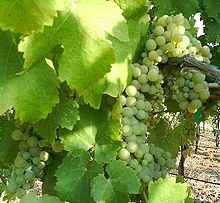| Viognier | |
|---|---|
| Grape (Vitis) | |
 Viognier in Viala & Vermorel | |
| Color of berry skin | Blanc |
| Species | Vitis vinifera |
| Also called | Bergeron, Barbin, Rebolot, Greffou, Picotin Blanc, Vionnier, Petiti Vionnier, Viogne, Galopine, Vugava bijela[1] (more) |
| Origin | Croatia, France |
| Notable regions | Worldwide |
| VIVC number | 13106 |

Viognier (French pronunciation: [vjɔɲje]) is a white wine grape variety. It is the only permitted grape for the French wine Condrieu in the Rhône Valley.[2]
Outside of the Rhône, Viognier can be found in regions of North and South America as well as Australia, New Zealand, the Cape Winelands in South Africa, south Moravia region in Czechia, Israel and in Austria at Weingut Roland Minkowitsch. In some wine regions, the variety is co-fermented with the red wine grape Syrah where it can contribute to the color and aroma of the wine.[3]
Like Chardonnay, Viognier has the potential to produce full-bodied wines with a lush, soft character. In contrast to Chardonnay, the Viognier varietal has more natural aromatics that include notes of peach, pears, violets and minerality. However, these aromatic notes can be easily destroyed by too much exposure to oxygen, which makes barrel fermentation a winemaking technique that requires a high level of skill on the part of any winemaker working with this variety.
The potential quality of Viognier is also highly dependent on viticultural practices and climate, with the grape requiring a long, warm growing season in order to fully ripen but not a climate that is so hot that the grape develops high levels of sugars and potential alcohol before its aromatic notes can develop. The grape is naturally a low-yielding variety, which can make it a less economically viable planting for some vineyards.[3]
- ^ "Viognier information". University of California, Davis Integrated Viticulture Online. Archived from the original on 2009-02-08. Retrieved 2008-08-25.
- ^ J. Robinson "The Oxford Companion to Wine" Third Edition pg 754 Oxford University Press 2006 ISBN 0-19-860990-6
- ^ a b Wine & Spirits Education Trust "Wine and Spirits: Understanding Wine Quality" pgs 6-9, Second Revised Edition (2012), London, ISBN 9781905819157